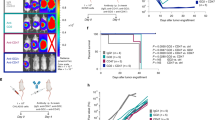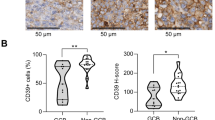Abstract
Immunotherapy with anti-GD2 monoclonal antibodies (mAbs) provides some benefits for patients with neuroblastoma (NB). However, the therapeutic efficacy remains limited, and treatment is associated with significant neuropathic pain. Targeting O-acetylated GD2 (OAcGD2) by 8B6 mAb has been proposed to avoid pain by more selective tumor cell targeting. Thorough understanding of its mode of action is necessary to optimize this treatment strategy. Here, we found that 8B6-mediated antibody-dependent cellular phagocytosis (ADCP) performed by macrophages is a key effector mechanism. But efficacy is limited by upregulation of CD47 expression on neuroblastoma cells in response to OAcGD2 mAb targeting, inhibiting 8B6-mediated ADCP. Antibody specific for the CD47 receptor SIRPα on macrophages restored 8B6-induced ADCP of CD47-expressing NB cells and improved the antitumor activity of 8B6 mAb therapy. These results identify ADCP as a critical mechanism for tumor cytolysis by anti-disialoganglioside mAb and support a combination with SIRPα blocking agents for effective neuroblastoma therapy.




Similar content being viewed by others
Availability of data and materials
The datasets used and/or analyzed during the current study are available from the corresponding author on reasonable request.
References
Pinto NR, Applebaum MA, Volchenboum SL et al (2015) Advances in risk classification and treatment strategies for neuroblastoma. J Clin Oncol 33:3008–3017
Monclair T, Brodeur GM, Ambros PF et al (2009) The International Neuroblastoma Risk Group (INRG) staging system: an INRG Task Force report. J Clin Oncol 27:298–303. https://doi.org/10.1200/JCO.2008.16.6876
Yu AL, Gilman AL, Ozkaynak MF et al (2010) Anti-GD2 antibody with GM-CSF, interleukin-2, and isotretinoin for neuroblastoma. N Engl J Med 363:1324–1334. https://doi.org/10.1056/NEJMoa0911123
Ladenstein R, Pötschger U, Valteau-Couanet D et al (2018) Interleukin 2 with anti-GD2 antibody ch14.18/CHO (dinutuximab beta) in patients with high-risk neuroblastoma (HR-NBL1/SIOPEN): a multicentre, randomised, phase 3 trial. Lancet Oncol 19:1617–1629. https://doi.org/10.1016/S1470-2045(18)30578-3
Kushner BH, Cheung IY, Modak S et al (2018) Humanized 3F8 anti-GD2 monoclonal antibody dosing with granulocyte-macrophage colony-stimulating factor in patients with resistant neuroblastoma: a phase 1 clinical trial. JAMA Oncol 4:1729–1735. https://doi.org/10.1001/jamaoncol.2018.4005
Ladenstein R, Weixler S, Baykan B et al (2013) Ch14.18 antibody produced in CHO cells in relapsed or refractory stage 4 neuroblastoma patients: a SIOPEN phase 1 study. MAbs 5:801–809. https://doi.org/10.4161/mabs.25215
Zeng Y, Fest S, Kunert R et al (2005) Anti-neuroblastoma effect of ch14.18 antibody produced in CHO cells is mediated by NK-cells in mice. Mol Immunol 42:1311–1319. https://doi.org/10.1016/j.molimm.2004.12.018
Siebert N, Jensen C, Troschke-Meurer S et al (2016) Neuroblastoma patients with high-affinity FCGR2A, -3A and stimulatory KIR 2DS2 treated by long-term infusion of anti-GD2 antibody ch14.18/CHO show higher ADCC levels and improved event-free survival. Oncoimmunology 5:e1235108. https://doi.org/10.1080/2162402X.2016.1235108
Munn DH, Cheung NKV (1990) Phagocytosis of tumor cells by human monocytes cultured in recombinant macrophage colony-stimulating factor. J Exp Med 172:231–237. https://doi.org/10.1084/jem.172.1.231
Jaiswal S, Jamieson CHM, Pang WW et al (2009) CD47 Is upregulated on circulating hematopoietic stem cells and leukemia cells to avoid phagocytosis. Cell 138:271–285. https://doi.org/10.1016/j.cell.2009.05.046
Barclay AN, van den Berg TK (2014) The interaction between signal regulatory protein alpha (SIRPα) and CD47: structure, function, and therapeutic target. Annu Rev Immunol 32:25–50. https://doi.org/10.1146/annurev-immunol-032713-120142
Majeti R, Chao MP, Alizadeh AA et al (2009) CD47 is an adverse prognostic factor and therapeutic antibody target on human acute myeloid leukemia stem cells. Cell 138:286–299. https://doi.org/10.1016/j.cell.2009.05.045
Weiskopf K, Ring AM, Ho CCM et al (2013) Engineered SIRPα variants as immunotherapeutic adjuvants to anticancer antibodies. Science 80(341):88–91. https://doi.org/10.1126/science.1238856
Chao MP, Alizadeh AA, Tang C et al (2010) Anti-CD47 antibody synergizes with rituximab to promote phagocytosis and eradicate non-Hodgkin lymphoma. Cell 142:699–713. https://doi.org/10.1016/j.cell.2010.07.044
Li Y (2019) CD47 Blockade and rituximab in non-Hodgkin’s lymphoma. N Engl J Med 380:497. https://doi.org/10.1056/NEJMc1816156
Petrova PS, Viller NN, Wong M et al (2017) TTI-621 (SIRPαFc): a CD47-blocking innate immune checkpoint inhibitor with broad antitumor activity and minimal erythrocyte binding. Clin Cancer Res 23:1068–1079. https://doi.org/10.1158/1078-0432.CCR-16-1700
Yanagita T, Murata Y, Tanaka D et al (2017) Anti-SIRPα antibodies as a potential new tool for cancer immunotherapy. JCI Insight. https://doi.org/10.1172/jci.insight.89140
Alvarez-Rueda N, Desselle A, Cochonneau D et al (2011) A monoclonal antibody to O-acetyl-GD2 ganglioside and not to GD2 shows potent anti-tumor activity without peripheral nervous system cross-reactivity. PLoS ONE 6:e25220. https://doi.org/10.1371/journal.pone.0025220
Cochonneau D, Terme M, Michaud A et al (2013) Cell cycle arrest and apoptosis induced by O-acetyl-GD2-specific monoclonal antibody 8B6 inhibits tumor growth in vitro and in vivo. Cancer Lett 333:194–204. https://doi.org/10.1016/j.canlet.2013.01.032
Terme M, Dorvillius M, Cochonneau D et al (2014) Chimeric antibody c.8B6 to O-acetyl-GD2 mediates the same efficient anti-neuroblastoma effects as therapeutic ch14.18 antibody to GD2 without antibody induced allodynia. PLoS One 9:e87210. https://doi.org/10.1371/journal.pone.0087210
Gholamin S, Mitra SS, Feroze AH et al (2017) Disrupting the CD47-SIRPα anti-phagocytic axis by a humanized anti-CD47 antibody is an efficacious treatment for malignant pediatric brain tumors. Sci Transl Med. https://doi.org/10.1126/scitranslmed.aaf2968
Cerato E, Birkle S, Portoukalian J et al (1997) Variable region gene segments of nine monoclonal antibodies specific to disialogangliosides (G(D2), G(D3)) and their O-acetylated derivatives. Hybridoma 16:307–316. https://doi.org/10.1089/hyb.1997.16.307
Chuang W, Lagenaur CF (1990) Central nervous system antigen P84 can serve as a substrate for neurite outgrowth. Dev Biol 137:219–232. https://doi.org/10.1016/0012-1606(90)90249-I
Gauttier V, Pengam S, Durand J et al (2020) Selective SIRPα blockade reverses tumor T cell exclusion and overcomes cancer immunotherapy resistance. J Clin Investig 130:6109–6123. https://doi.org/10.1172/JCI135528
Trouplin V, Boucherit N, Gorvel L et al (2013) Bone marrow-derived macrophage production. J Vis Exp. https://doi.org/10.3791/50966
Shi Y, Fan X, Deng H et al (2015) Trastuzumab triggers phagocytic killing of high HER2 cancer cells in vitro and in vivo by interaction with Fcγ receptors on macrophages. J Immunol 194:4379–4386. https://doi.org/10.4049/jimmunol.1402891
Lode HN, Xiang R, Varki NM et al (1997) Targeted interleukin-2 therapy for spontaneous neuroblastoma metastases to bone marrow. J Natl Cancer Inst 89:1586–1594. https://doi.org/10.1093/jnci/89.21.1586
Faraj S, Bahri M, Fougeray S et al (2018) Neuroblastoma chemotherapy can be augmented by immunotargeting O-acetyl-GD2 tumor-associated ganglioside. Oncoimmunology. https://doi.org/10.1080/2162402X.2017.1373232
Fleurence J, Bahri M, Fougeray S et al (2020) Impairing temozolomide resistance driven by glioma stem-like cells with adjuvant immunotherapy targeting O-acetyl GD2 ganglioside. Int J Cancer 146:424–438. https://doi.org/10.1002/ijc.32533
Nair A, Jacob S (2016) A simple practice guide for dose conversion between animals and human. J Basic Clin Pharm 7:27. https://doi.org/10.4103/0976-0105.177703
Zhao XW, Kuijpers TW, Van Den Berg TK (2012) Is targeting of CD47-SIRPα enough for treating hematopoietic malignancy? Blood 119:4333–4334
Long AH, Highfill SL, Cui Y et al (2016) Reduction of MDSCs with all-trans retinoic acid improves CAR therapy efficacy for sarcomas. Cancer Immunol Res 4:869–880. https://doi.org/10.1158/2326-6066.CIR-15-0230
Troschke-Meurer S, Siebert N, Marx M et al (2019) Low CD4+/CD25+/CD127− regulatory T cell- and high INF-γ levels are associated with improved survival of neuroblastoma patients treated with long-term infusion of ch14.18/CHO combined with interleukin-2. Oncoimmunology. https://doi.org/10.1080/2162402X.2019.1661194
Raffaghello L, Marimpietri D, Pagnan G, et al (2003) Anti-GD2 monoclonal antibody immunotherapy: a promising strategy in the prevention of neuroblastoma relapse. In: Cancer letters. Elsevier Ireland Ltd, pp 205–209
Kushner BH, Cheung NK (1989) GM-CSF enhances 3F8 monoclonal antibody-dependent cellular cytotoxicity against human melanoma and neuroblastoma. Blood 73:1936–1941
Cheung N-KV, Sowers R, Vickers AJ et al (2006) FCGR2A polymorphism is correlated with clinical outcome after immunotherapy of neuroblastoma with anti-GD2 antibody and granulocyte macrophage colony-stimulating factor. J Clin Oncol 24:2885–2890. https://doi.org/10.1200/JCO.2005.04.6011
Petty AJ, Yang Y (2017) Tumor-associated macrophages: implications in cancer immunotherapy. Immunotherapy 9:289–302
Asgharzadeh S, Salo JA, Ji L et al (2012) Clinical significance of tumor-associated inflammatory cells in metastatic neuroblastoma. J Clin Oncol 30:3525–3532. https://doi.org/10.1200/JCO.2011.40.9169
Song L, Asgharzadeh S, Salo J et al (2009) Valpha24-invariant NKT cells mediate antitumor activity via killing of tumor-associated macrophages. J Clin Investig 119:1524–1536. https://doi.org/10.1172/JCI37869
Wu HW, Sheard MA, Malvar J et al (2019) Anti-CD105 antibody eliminates tumor microenvironment cells and enhances anti-GD2 antibody immunotherapy of neuroblastoma with activated natural killer cells. Clin Cancer Res 25:4761–4774. https://doi.org/10.1158/1078-0432.CCR-18-3358
Siebert N, Zumpe M, Jüttner M et al (2017) PD-1 blockade augments anti-neuroblastoma immune response induced by anti-GD2 antibody ch14.18/CHO. Oncoimmunology. https://doi.org/10.1080/2162402X.2017.1343775
Chen J, Zheng DX, Yu XJ et al (2019) Macrophages induce CD47 upregulation via IL-6 and correlate with poor survival in hepatocellular carcinoma patients. Oncoimmunology. https://doi.org/10.1080/2162402X.2019.1652540
Tsao L-C, Crosby EJ, Trotter TN et al (2019) CD47 blockade augmentation of trastuzumab antitumor efficacy dependent on antibody-dependent cellular phagocytosis. JCI Insight. https://doi.org/10.1172/jci.insight.131882
Weiskopf K (2017) Cancer immunotherapy targeting the CD47/SIRPα axis. Eur J Cancer 76:100–109
Advani R, Flinn I, Popplewell L et al (2018) CD47 blockade by Hu5F9-G4 and rituximab in non-Hodgkin’s lymphoma. N Engl J Med 379:1711–1721. https://doi.org/10.1056/NEJMoa1807315
Webb ER, Lanati S, Wareham C et al (2020) Immune characterization of pre-clinical murine models of neuroblastoma. Sci Rep. https://doi.org/10.1038/s41598-020-73695-9
Zhao XW, Van Beek EM, Schornagel K et al (2011) CD47-signal regulatory protein-α (SIRPα) interactions form a barrier for antibody-mediated tumor cell destruction. Proc Natl Acad Sci USA 108:18342–18347. https://doi.org/10.1073/pnas.1106550108
Acknowledgements
We thank for their technical assistance the following facilities: plateau de cytométrie en flux et de tri cellulaire CYTOCELL, plateforme de Protéines Recombinantes P2R and Unité Thérapeutique Expérimentale UTE, and Wolfgang Hartmann, Gerhard-Domagk-Institute of Pathology, University Hospital Muenster.
Funding
This work was supported by La Ligue contre le Cancer (comités 44 et 56), the Fondation BMS pour la recherche en Immuno-oncologie, the Institut National du Cancer, and the Fondation de l’Université de Nantes.
Author information
Authors and Affiliations
Contributions
M.B. contributed to conceptualization, methodology, validation, formal analysis, investigation, and visualization. S.K. contributed to methodology, validation, formal analysis, and visualization. S.V. and N.G. contributed to methodology, validation, and formal analysis. C.R. contributed to conceptualization, resources, and writing—review and editing. F.P. acquired funding and contributed to writing—review and editing. S.F. contributed to conceptualization, methodology, investigation, and supervision and administrated the project. S.B. contributed to conceptualization, methodology, investigation, writing—original draft, visualization, and supervision, administrated the project, and acquired funding.
Corresponding author
Ethics declarations
Conflict of interest
MB, SV, SF, and SB are inventors of a granted patent covering the therapeutic uses of monoclonal antibodies targeting O-acetyl GD2 gangliosides.
Additional information
Publisher's Note
Springer Nature remains neutral with regard to jurisdictional claims in published maps and institutional affiliations.
Supplementary Information
Below is the link to the electronic supplementary material.
Rights and permissions
About this article
Cite this article
Bahri, M., Kailayangiri, S., Vermeulen, S. et al. SIRPα-specific monoclonal antibody enables antibody-dependent phagocytosis of neuroblastoma cells. Cancer Immunol Immunother 71, 71–83 (2022). https://doi.org/10.1007/s00262-021-02968-7
Received:
Accepted:
Published:
Issue Date:
DOI: https://doi.org/10.1007/s00262-021-02968-7




